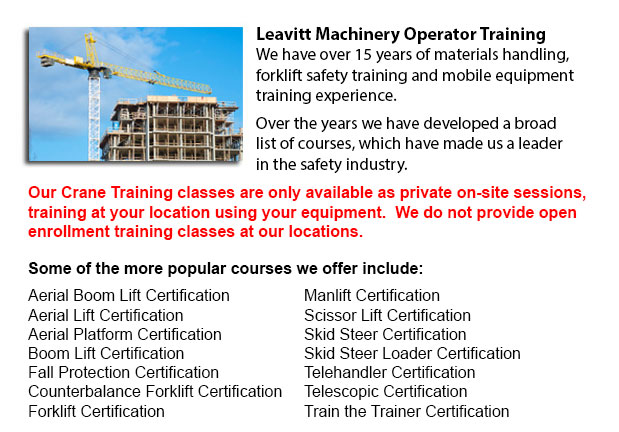
Ontario Overhead Crane Safety Training - Overhead crane safety training equips operators with skills and knowledge regarding crane safety precautions, accident avoidance, materials handling, and machinery and stock protection. Trainees would learn the kinds of overhead cranes, their capabilities and their uses in various industry settings. For operators who are trained and licensed, the shift in liability moves from the company to the operator. Thus, the course emphasizes individual operator duties.
The operators in the overhead safety training course would be given instruction on the proper ways for carrying out inspections: the pre-shift inspection and the more detailed in-depth inspection. These are important daily routines that should be logged. Correctly recorded pre-shift checks help to protect the company from liability in case of an accident. Pre-shift inspections likewise prevent expensive repairs, accidents and damage. Operators learn how to designate a particular person to handle inspections, how to maintain the log book and how to report problems.
Each inspection must be documented and carried out regularly. Things which should be inspected for possible problems, include: increase in the throat opening, hooks for cracks, hoist ropes for corrosion, degree of twist, worn wires, loss of diameter, kinks and bird caging, broken wires, heat and chemical damage; chains for nicks and gouges, twists, corrosion and cracks, excessive wear, distortion, stretching, pits, damage caused by extreme heat.
The operator would get to learn the correct techniques about correct rigging procedures. The process of rigging involves the understanding of the manufacturer's data plate, determining the weight of materials to be lifted, choosing the gear, and utilizing safe practices to secure the load. The course cover in detail the following: safe working loads, and the capacities of chains, ropes, shackles, slings and hooks.
It is vital to understand who can operate the cranes at your facility, the job's physical requirements, and operator credentials required for specialized tasks and permits. Safety is a priority when operating in the vicinity of pedestrian traffic.
The responsibilities included in the safe crane use includes undertaking visual inspections, checking for hydraulic leaks, checking the safety guards, testing the controls, examining the hoist rope and hook, braking mechanisms and limit switches. Correct reporting procedures are vital. These subject matters are all covered in depth in the course.
The program likewise consists of the right lifting and moving procedures with cranes and hoists. Operators would also learn right hand signals. Training includes how to attach the load, raise the load, abort a lift, set the load and unhook the slings.
The steps involved with moving the load, includes: starting and stopping procedures, guiding and controlling the load, working with signals and observing working conditions. In the event of power failures, the operator would need to know how to proceed. The program includes techniques for removing the slings and lowering the load, parking the crane, storage equipment, and securing an outdoor and indoor crane.
-
Ontario Manlift Certification
Ontario Manlift Certification - The Elevated Platforms and Manlifts Certification course helps to provide the required training on the work practices, safe operating procedures, regulations and rules regarding the everyday activities for the operator... More -
Ontario Crane Training
Ontario Crane Training - Bridge cranes or overhead cranes are actually a type of industrial material handling crane making use of a line and hook mechanism that runs on a horizontal beam running along two widely separated rails. Various overhead cran... More -
Ontario Aerial Lift Train the Trainer
Ontario Aerial Lift Train the Trainer - The Aerial Lifts Train the Trainer Certification Program teaches trainers how to effectively train operators in safe industrial mobile machinery operation. Trainers are given in-depth instruction about aerial l... More -
Ontario Warehouse Forklift Training Classes
Ontario Warehouse Forklift Training Classes - The reason for warehouse training classes are to raise the awareness of common workplace dangers. The trainees will learn essential warehouse safety procedures. An emphasis is placed on paying attention t... More -
Ontario Forklift Training School
Ontario Forklift Training School - Forklift Training School - Industry and federal regulators have established the criteria for forklift safety training based on their current standards and regulations. Those wanting to operate a forklift must finish... More -
Skid Steer Loader Training in Ontario
The engine powered skid-steer loader consists of a rigid and small frame, equipped along with lift arms that could attach to lots of industrial tools and attachments to execute many labor saving jobs. Normally, skid-steer loaders are four-wheel drive... More -
Ontario Crane License
Ontario Crane License - Crane operators ought to be "credentialed", that means they ought to own a crane operator certification or license. Credentialing is considered a mandatory governmental requirement to be able to practice as an operator of a cr... More -
Ontario Forklift Operator Training
Ontario Forklift Operator Training - Forklift training is a prerequisite in North America and is intended to prevent workplace injuries and death. Forklift training offers driver training intended for forklift operators. Training programs teach the s... More

Forklift Certification Ontario
TOLL FREE: 1-888-254-6157
Toronto, Ontario
forkliftcertificationontario.com
Email Us
About Us


